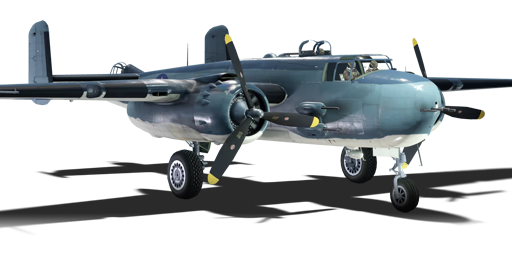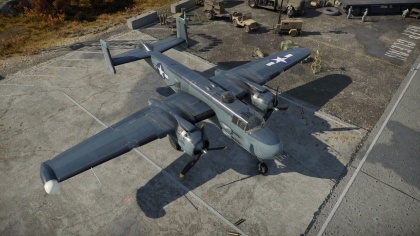PBJ-1H
Contents
Description
The PBJ-1H Mitchell is a Rank III American attacker with a battle rating of 4.0 (AB/RB) and 4.3 (SB). It was introduced in Update 1.41.
The PBJ-1H is U.S. Navy variant of the B-25 which was operated by the U.S. Marine Corps as a ground attacker. This aircraft is a powerful ground strafing machine and due to the weapons package built in, it can be viewed as a gunship. With eight 12.7 mm machine guns and a 75 mm cannon, most light ground targets such as AAA positions and Artillery positions can be destroyed. The 75 mm T13E1 cannon is similar to the 75 mm M3 on the Sherman tank, and shares its powerful support capability. With Armored Targets belt loaded, it can knock out light pillboxes with ease and greater accuracy than bombs in Realistic and Simulator modes. It is even effective against light and medium tanks, although the low fire rate makes it less than ideal for strafing several targets in a short target window. It is recommended to use the virtual cockpit view to aim the main gun. The 12.7 mm guns should be mainly utilized against "soft" targets such as Armored Cars, AAA and Artillery positions, and the 75 mm Gun against hardened targets such as light pillboxes and tanks. That said, the concentrated MG fire can also be used to destroy light pillboxes (with practice), though will require significant ammo usage to do so.
Despite armament differences, the airframe of the PBJ is still that of the B-25. While this means that it will have a relatively large number of defensive weapons, it also means that it is relatively sluggish compared to other close-support aircraft. It also presents a relatively large and slow moving, though semi-well-defended target. Beware all variants of the Bell P-39 Airacobra , P-63 Kingcobra, P-47 Thunderbolt, all variants of the Me 410s and the Yak-9T; these aircraft can destroy your aircraft without much difficulty, where as you will have a difficult time expending numerous 12.7 mm rounds trying to knock them out of the sky or off your tail.
This aircraft has several weaknesses in which the pilot must be aware which could be exploited by attacking aircraft. First, the twin rudders in the tail section create gunner dead zones. The rudders will prevent the side gunners and to an extent the dorsal gunner from firing on an enemy attacking from the shadow of either of these two spots. The tail gunner should be able to neutralize this weakness as long as he has not been knocked out. The underside of the aircraft is especially vulnerable as there is no ventral turret and the tail gunner, side gunners only have a limited downward angle in which they can shoot, so it may be best to fly as low as possible in certain circumstances. Even with the great fire-power utilized on this aircraft, the pilot's best bet will be to operate under fighter cover when possible.
Other differences from the B-25 are the smaller bomb payload, attacker spawn location (lower altitude than bombers) and the lack of a bomb-sight view for precision bombing.
General info
Flight Performance
| Characteristics | |||||||
|---|---|---|---|---|---|---|---|
| Stock | |||||||
| Max Speed (km/h at 4,390 m) |
Max altitude (meters) |
Turn time (seconds) |
Rate of climb (meters/second) |
Take-off run (meters) | |||
| AB | RB | AB | RB | AB | RB | ||
| 427 | 414 | 5,800 | 38.9 | 33.9 | 4.1 | 5.3 | 850 |
| Upgraded | |||||||
| Max Speed (km/h at 4,390 m) |
Max altitude (meters) | Turn time (seconds) | Rate of climb (meters/second) |
Take-off run (meters) | |||
| AB | RB | AB | RB | AB | RB | ||
| 477 | 451 | 5,800 | 35.2 | 37.0 | 12.8 | 7.7 | 850 |
Details
| Features | ||||
|---|---|---|---|---|
| Combat flap | Take-off flap | Landing flap | Air brakes | Arrestor gear |
| ✓ | ✓ | ✓ | X | X |
| Limits | ||||
|---|---|---|---|---|
| Wing-break speed (km/h) |
Gear limit (km/h) |
Combat flap (km/h) |
Max Static G | |
| + | - | |||
| 580 | 350 | 340 | ~4 | ~2 |
| Optimal velocities | |||
|---|---|---|---|
| Ailerons (km/h) |
Rudder (km/h) |
Elevators (km/h) |
Radiator (km/h) |
| < 300 | < 270 | < 350 | > 240 |
| Compressor (RB/SB) | ||
|---|---|---|
| Setting 1 | ||
| Optimal altitude | 100% Engine power | WEP Engine power |
| 524 m | 3,000 hp | 3,339 hp |
| Setting 2 | ||
| Optimal altitude | 100% Engine power | WEP Engine power |
| 3,700 m | 2,700 hp | 3,005 hp |
Survivability and armour
- 8 mm Steel - Lower nose armor plate
- 8 mm Steel - Pilot and Co-pilot's seats
- 9.5 mm Steel - Fore cockpit armor plate
- 9.5 mm Steel - Side armor cockpit plates
- 9.5 mm Steel - Cockpit rear plate
- 9.5 mm Steel - Dorsal gunner aft plate
- 6.35 mm Steel - Side gunners armor plate x 2
- 9.5 mm Steel - Tail gunner protective armor plate
- 12 mm Bulletproof glass - Dorsal gunner turret
- 38 mm Bulletproof glass - Tail gunner canopy
Armaments
Offensive armament
The PBJ-1H is armed with:
- 1 x 75 mm T13E1 cannon (21 rounds)
- 4 x 12.7 mm Browning M2 machine gun, nose-mounted (400 rpg = 1,600 total)
- 4 x 12.7 mm Browning M2 machine gun, cheek-mounted (400 rpg = 1,600 total)
Suspended armament
The PBJ-1H can be outfitted with the following ordinance:
- Without load
- 12 x 100 lb AN-M30A1 bombs (600 lb total)
- 8 x 250 lb AN-M57 bombs (2,000 lb total)
- 4 x 500 lb AN-M64A1 bombs (2,000 lb total)
Defensive armament
The PBJ-1H is defended by:
- 2 x 12.7 mm Browning M2 machine gun, dorsal turret (400 rpg = 800 total)
- 2 x 12.7 mm Browning M2 machine gun, ventral turret (600 rpg = 1,200 total)
- 1 x 12.7 mm Browning M2 machine gun, 2 x beam turret (250 rpg)
Usage in the battles
Manual Engine Control
| MEC elements | ||||||
|---|---|---|---|---|---|---|
| Mixer | Pitch | Radiator | Supercharger | Turbocharger | ||
| Oil | Water | Type | ||||
| Controllable | Not controllable | Not controllable | Not controllable | Separate | Not ontrollable | Not controllable |
Modules
| Tier | Flight performance | Survivability | Weaponry | ||
|---|---|---|---|---|---|
| I | Fuselage Repair | Radiator | Protective Vest | Offensive 12 mm | SBC-25 |
| II | Compressor | Airframe | New 12 mm MGs | MBC-25 | |
| III | Wings Repair | Engine | Turret 12 mm | Offensive 75 mm | |
| IV | Engine Injection | Cover | New 12 mm MGs (turret) | New 75 mm Cannons | |
Pros and cons
Pros:
- Immense firepower in the form of eight 12.7 mm machine guns and a 75 mm cannon in the nose
- Excellent defensive firepower, utilizing most of the B-25 Mitchell's gun positions
- Durable air frame which can withstand numerous hits before going down
- Tricycle landing gear makes takeoff and landing easier
Cons
- 75 mm cannon fires so slow that it is usually impossible to kill more than 2 tanks when passing over a convoy
- Recoil from 75 mm cannon will literally yank the entire plane's nose off target
- Default belt for 75mm cannon alternates between HE and APT shells, giving mixed results
- Payload is limited compared to B-25 Mitchell, and configured as a dive bomber rather than level bomber
- Performance is sluggish at best
- Twin tails create blind spot for gunners, a trait carried by the B-25 Mitchell
History
Describe the history of the creation and combat usage of the aircraft in more detail than in the introduction. If the historical reference turns out to be too big, take it to a separate article, taking a link to an article about the vehicle and adding a block "/ historical reference" (example: https://wiki.warthunder.com/Name-vehicles/historical reference) and add a link to it here using the main template. Be sure to include links to sources at the end of the article.
Media
An excellent addition to the article will be video guides, as well as screenshots from the game and photos.
Read also
Links to the articles on the War Thunder Wiki that you think will be useful for the reader, for example,
- reference to the series of the aircraft;
- links to approximate analogues of other nations and research trees.
Sources
Paste links to sources and external resources, such as:
- topic on the official game forum;
- page on aircraft encyclopedia;
- other literature.
| USA strike aircraft | |
|---|---|
| Douglas | A-20G-25 · A-26B-10 · A-26B-50 · A2D-1 · AD-2 · AD-4 · A-1H |
| North American | A-36 · PBJ-1H · PBJ-1J |
| Other | AM-1 · AU-1 · XA-38 |





